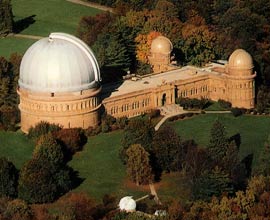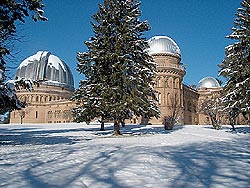
The Yerkes Observatory has been sold, but the venerable institution will continue operations as a scientific and educational facility.
The University of Chicago has reached an $8 million sale agreement with a private developer to preserve the venerable Yerkes Observatory, one of the world's great astronomical landmarks. Under the terms of the agreement, Mirbeau Companies of Skaneateles, New York, will develop 45 acres of land around the historic observatory, but the observatory's three major telescopes will continue to be used for research and education.
Dedicated in 1897, Yerkes Observatory continues to house the world's largest refractor — the great 40-inch commissioned by George Ellery Hale. The observatory is also home to 41- and 24-inch reflectors. Some of the great luminaries of 20th-century astronomy spent part or most of their careers at Yerkes, including Edward Emerson Barnard, Edwin P. Hubble, and Subrahmanyan Chandrasekhar. But given the site's near-sea-level elevation and the cloudy, light-polluted environment in Williams Bay, Wisconsin, the observatory has long since faded as an important research facility.
Faced with the observatory's low level of scientific productivity and $300,000 annual maintenance costs, the University of Chicago has been entertaining offers for several years. Mirbeau's owners, Gary and Linda Dower, offered a reported $10 million to purchase the facility and surrounding land in 2004. In October 2005, Illinois-based Aurora University offered $4.5 million for the observatory.
The university has decided to accept the Mirbeau offer largely because the tax revenue can support the observatory. The agreement allows the company to build a 100-room inn and 70 to 75 small houses adjacent to the observatory. But the deal also preserves the observatory itself and 30 acres of surrounding land, by deeding the property to the town of Williams Bay, which will create an Exposition District. It preserves the entire 522-foot strip of land along the shore of nearby Lake Geneva. Proceeds from the sale and future property taxes will provide $400,000 of annual funds to support the observatory as an education and outreach facility. The $8 million from the sale will support astronomical research at the university. Mirbeau has agreed to abide by the International Dark-Sky Association's lighting guidelines.

Yerkes Observatory's main building houses the 40-inch refractor (in the 90-foot-diameter dome on the left side of this December 1st photo) and 41-inch and 24-inch 24-inch reflectors (in the central and right-hand domes, respectively). The century-old observatory has had to contend with frequent clouds and a near-sea-level elevation while competing facilities arose on mountaintops in California, Arizona, and elsewhere.
"Yerkes Observatory owns a wonderful place in the history of astronomy," says University of Chicago president Don Randel in a press release. "But modern astronomy long ago moved on, and the university needs to stay focused on what we do best, which is advancing the frontiers of knowledge. This new plan meets all three of our goals for Yerkes. It provides a secure funding stream to preserve it as an outreach facility, it provides resources for future research in astronomy, and it proposes high-quality and environmentally sensitive development."
"We are honored to be part of this joint effort with the University of Chicago and the Village of Williams Bay to preserve the historic Yerkes Observatory," adds Gary Dower in a Mirbeau press release.
Before the agreement can be consummated, the town of Williams Bay must approve the sale for zoning and the creation of the Exposition District.
Angela Olinto, chair of the University of Chicago's Department of Astronomy and Astrophysics, tells Sky & Telescope that the university could have made more money from the sale if it had no concern for the observatory's future. "We could have just asked for the best buck for the facility, but we felt it was worth sacrificing millions of dollars to guarantee the legacy and future of the observatory," she says. "We didn't take this sale lightly. We didn't want to just turn off the lights. We want to make something for the future of this observatory. We put a lot of energy into finding a creative approach."
 0
0
Comments
You must be logged in to post a comment.